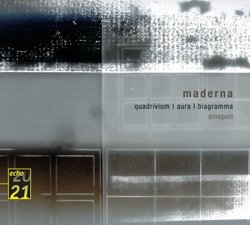| All Artists: Bruno Maderna, Giuseppe Sinopoli, NDR Symphony Orchestra (Hamburg), Sinfonieorchester Des Norddeutschen Rundfunks Hamburg Title: Maderna: Quadrivium; Aura; Biogramma Members Wishing: 0 Total Copies: 0 Label: Deutsche Grammophon Release Date: 2/8/2005 Genre: Classical Styles: Forms & Genres, Concertos, Historical Periods, Modern, 20th, & 21st Century, Symphonies Number of Discs: 1 SwapaCD Credits: 1 UPC: 028947753834 |
Search - Bruno Maderna, Giuseppe Sinopoli, NDR Symphony Orchestra (Hamburg) :: Maderna: Quadrivium; Aura; Biogramma
 | Bruno Maderna, Giuseppe Sinopoli, NDR Symphony Orchestra (Hamburg) Maderna: Quadrivium; Aura; Biogramma Genre: Classical
|
Larger Image |
CD Details |
CD ReviewsExquisite, refined orchestral works R. Hutchinson | a world ruled by fossil fuels and fossil minds | 03/19/2005 (5 out of 5 stars) "For someone like me, coming along in the New Millennium opening an ear to the 20th century modernists, Bruno Maderna is virtually a lost and forgotten figure. His name is bandied about as one of the key members of the Darmstadt Circle along with Berio, Boulez, Ligeti, Nono, Ligeti, Stockhausen and Xenakis, but his music is difficult to locate. This reissue in the DG 20/21 Echo series goes a long way toward remedying the situation. Here are three fine recordings of Maderna's orchestral works, performed by Giuseppe Sinopoli and the North German Radio Symphony Orchestra in 1979, and originally released in 1980. "Quadrivium" for percussion and orchestra was composed in 1969, and both "Aura" and "Biogramma" for orchestra were composed in 1972. It is fascinating to listen to this resolutely abstract modern music today, knowing what was taking place in Italy (the "Hot Autumn" of the New Left) and around the world ("people all around the world are shouting End the War!", said the Temptations) at that time. This is not music that is easily appreciated on first listening. Maderna does not have an immediately recognizable voice comparable to Ligeti, Xenakis or Nono, three 20th century greats. However, if you give it a chance, it begins to open up and reveal its secrets. Maderna's music has depths. Like his string quartets, these orchestral works will reward listening to again and again." Virtuoso exciting music for orchestra scarecrow | Chicago, Illinois United States | 03/12/2005 (5 out of 5 stars) "Maderna was well loved, well respected composer conductor,he emerged from the post-war generation of composers,taught at Darmstadt Summer Courses.Boulez dedicated his "Rituel" for Orchestra to his memory. He studied conducting with Hermann Scherchen one of the first post-war power brokers who expressed an interest in this post war generation with performances of works as Boulez, Xenakis, Stockhausen, Maderna followed Boulez's paradigm that the avant-garde needs performers and conductors not simply more creators, something that is painfully true today.
Maderna however always kept his composing pen ready for immediate distributions of his imagination. He had a wonderful sense of timbre in any genre,solo to orchestral and had an affinity for the "freedom"and power music of dodecaphonic content can take on. He was quite original in that sense however never really abandoning the "gravitas" of his generation.You can say his music is intellectually "playful" light,but not entirely so. He thought however that contemporary music should not follow whole heartedly a fixed template for concept, gesture or expression, there should be no Master Signifier. These three works for large orchestra are master works if we can still utilize that term.Condusted brilliantly by the late Sinopoli who brings his high dramatic sense to these works. These works are difficult to perform in that you need to up-the anti in terms of timbre, you must tread a fine line between this aggressive demanor and a reserved one. Written toward the end of his life. "Quadrivium" or "crossroads" is a good example of these imaginative 'freedoms' where the conductor must cue the entrances of the four orchestral groups demarcated. There is also an indeterminate of intervallic projection where tones are presented at times within boxes surrounding the music systems, the player can begin at any tone and proceed ad libitum. Maderna here has a real earthly sense of timbre beginning with snarling trombones and a large array of the four percussionists that function much like soloists in a'concerti grossi'. They quite literally surround the orchestra with their sound. You feel the pure joy "jouissance" of pointillistic timbre here in "Quadrivium".There are 7 tempi indication all divided admirably on this CD, it makes for good contrasts. Maderna thought in structural terms of "Blocs" of timbre, not "movements" so much as simple "pieces" of music that are brought together,co-existing,self-contained.Yes his personalty brings this together much of the time. From his brutal nature the opening here of quasi-misterioso percussion much like Berg's "Three Pieces of Orchestra" a work he knew quite well, there is always a high register violin melos that brings the relative anarchy of the pointillistic percussion and thunderous tomo-tom tympani mixed with muted trombones and tuba together. Likewise "Aura" a piece I heard live; a Chicago Symphony Commission has a more lyrical content to it yet it does break with movements into snarling trumpets. There is a much more affinity for "walls" or "screens" of orchetral sound here.;divisi strings; Much more so than "Biogramma" also writtin in 1972,here the piano or pitched percussion take center role, yet Maderna's affinity for the melos, the lyrical line finds the oboe and English Horn the soloists. Maderna had written much for those instruments in collaboration with Lothar Faber.So it is like his """host" coming to the fore here." |

 Track Listings (20) - Disc #1
Track Listings (20) - Disc #1